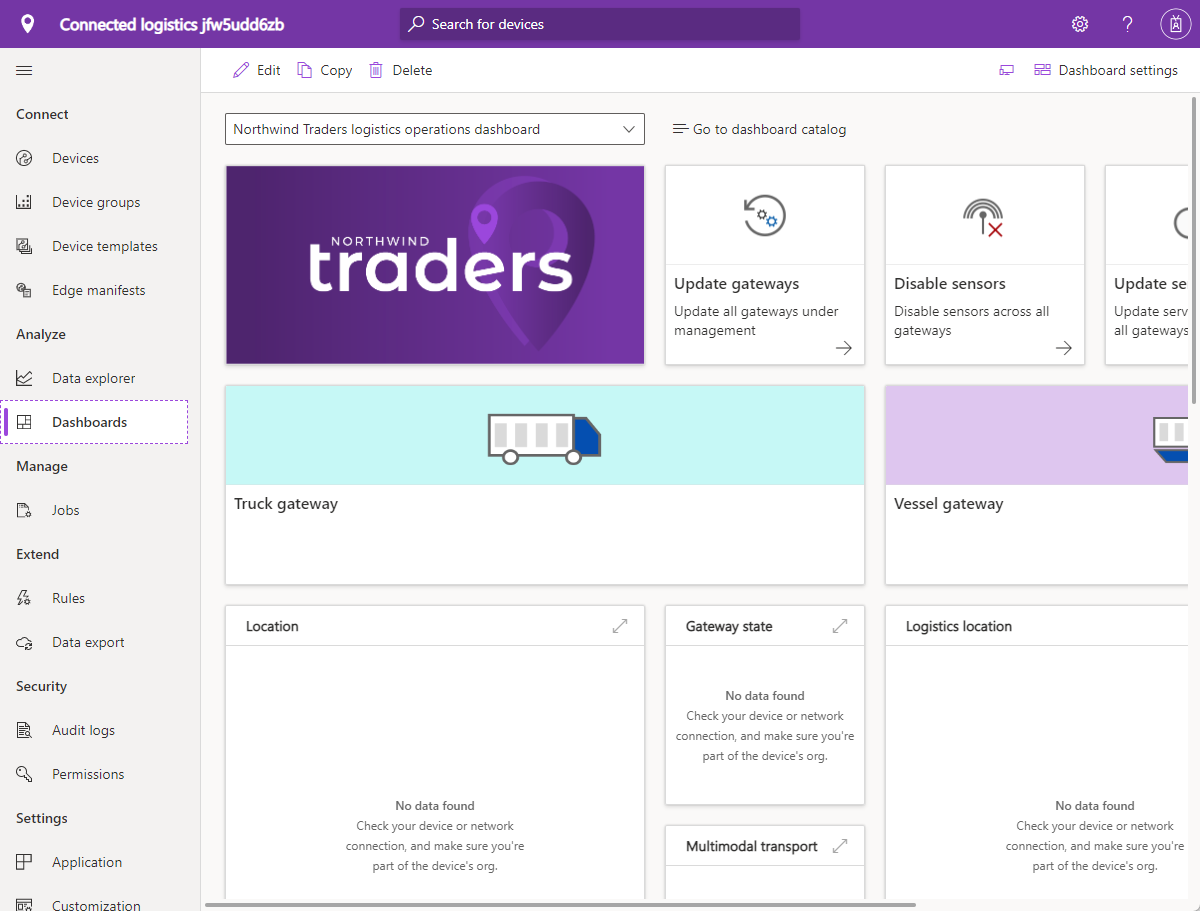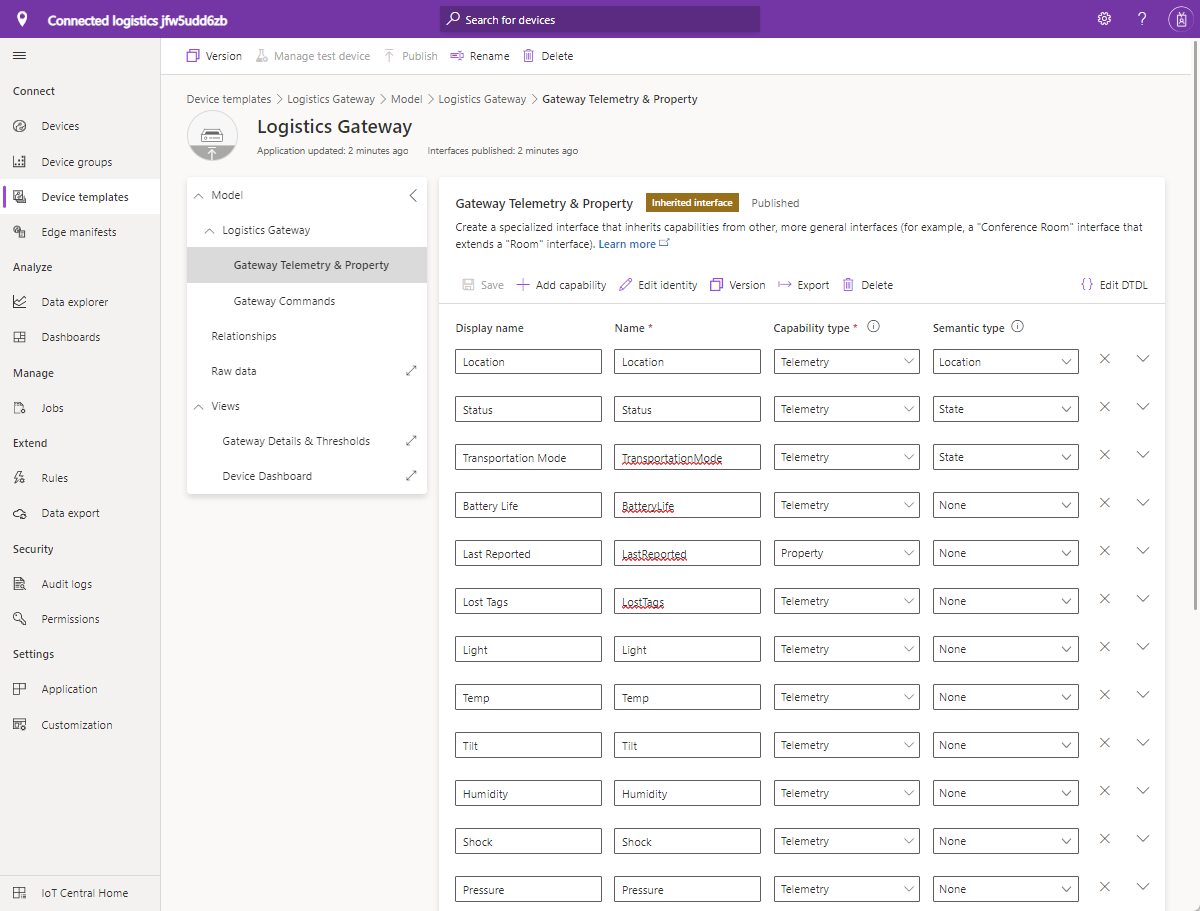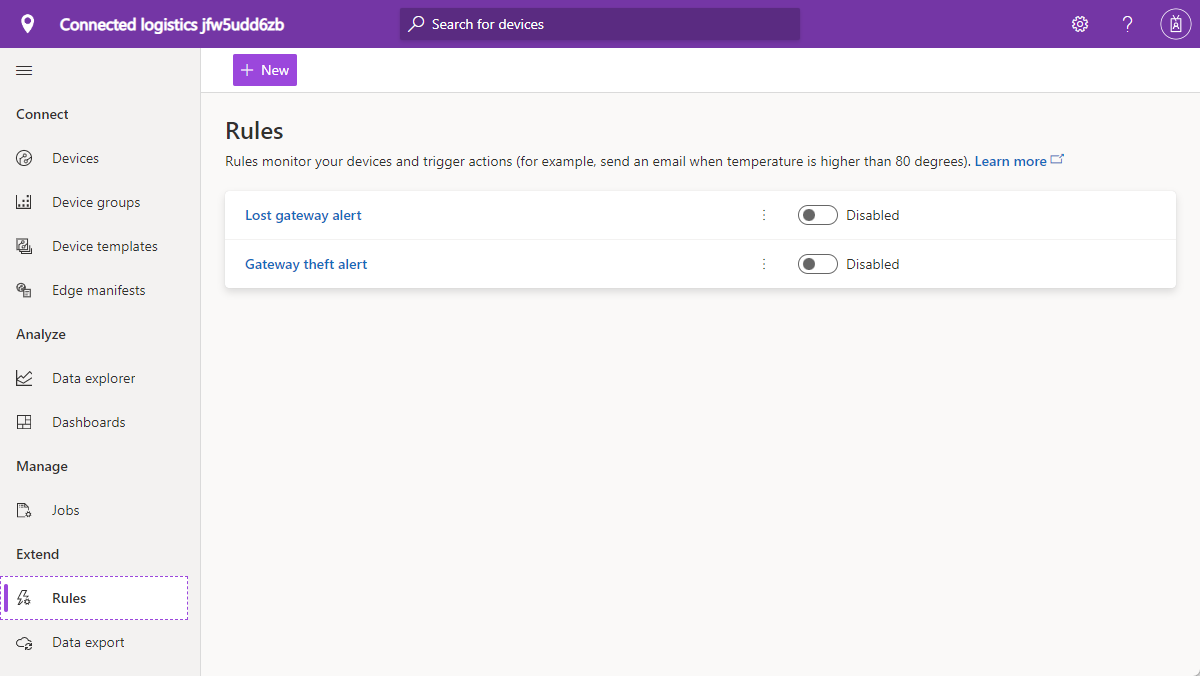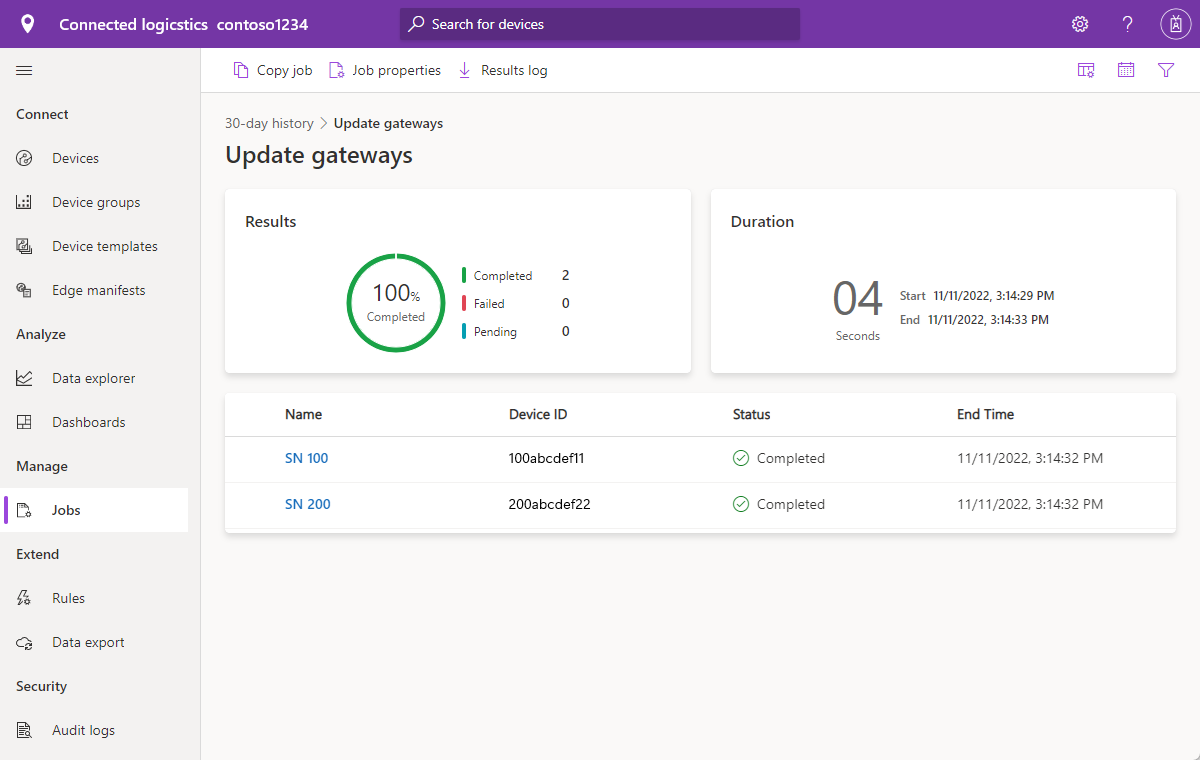Note
Access to this page requires authorization. You can try signing in or changing directories.
Access to this page requires authorization. You can try changing directories.
In this tutorial, you learn how to deploy and use an IoT Central connected logistics application from an application template. Global logistics spending is expected to reach $10.6 trillion in 2020. Transportation of goods accounts for most of this spending and shipping providers are under intense competitive pressure and constraints.
You can use IoT sensors to collect and monitor ambient conditions such as temperature, humidity, tilt, shock, light, and the location of a shipment. In cloud-based business intelligence systems, you can combine telemetry gathered from sensors and devices with other data sources such as weather and traffic information.
The benefits of a connected logistics solution include:
- Shipment monitoring with real-time tracing and tracking.
- Shipment integrity with real-time ambient condition monitoring.
- Security from theft, loss, or damage of shipments.
- Geo-fencing, route optimization, fleet management, and vehicle analytics.
- Forecasting for predictable departure and arrival of shipments.
In this tutorial, you:
- Create a connected logistics application
- Use the key features in the application
- Use a dashboard to show the critical logistics device operations activity
- Use a device template
- Use rules
- Use jobs
Prerequisites
An active Azure subscription. If you don't have an Azure subscription, create a free account before you begin.
Solution architecture

IoT tags (1) provide physical, ambient, and environmental sensor capabilities such as temperature, humidity, shock, tilt, and light. IoT tags typically connect to gateway device through Zigbee (802.15.4). Tags are less expensive sensors and can be discarded at the end of a typical logistics journey to avoid challenges with reverse logistics.
Gateways (2) enable upstream Azure IoT cloud connectivity using cellular or Wi-Fi channels. Bluetooth, NFC, and 802.15.4 Wireless Sensor Network modes are used for downstream communication with IoT tags. Gateways provide end-to-end secure cloud connectivity, IoT tag pairing, sensor data aggregation, data retention, and the ability to configure alarm thresholds.
Azure IoT Central is a solution development platform that simplifies IoT device connectivity, configuration, and management. The platform significantly reduces the burden and costs of IoT device management, operations, and related developments. You can build end-to-end enterprise solutions to achieve a digital feedback loop in logistics.
The IoT Central platform provides rich extensibility options through data export and APIs (3). Business insights based on telemetry data processing or raw telemetry are typically exported to a preferred line-of-business application (4,5).
This tutorial shows you how to get started with the IoT Central connected logistics application template. You learn how to deploy and use the template.
Create connected logistics application
To create your IoT Central application:
Navigate to the Create IoT Central Application page in the Azure portal. If prompted, sign in with your Azure account.
Enter the following information:
Field Description Subscription The Azure subscription you want to use. Resource group The resource group you want to use. You can create a new resource group or use an existing one. Resource name A valid Azure resource name. Application URL The URL subdomain for your application. The URL for an IoT Central application looks like https://yoursubdomain.azureiotcentral.com.Template Connected Logistics Region The Azure region you want to use. Pricing plan The pricing plan you want to use. Select Review + create. Then select Create.
When the app is ready, you can navigate to it from the Azure portal:
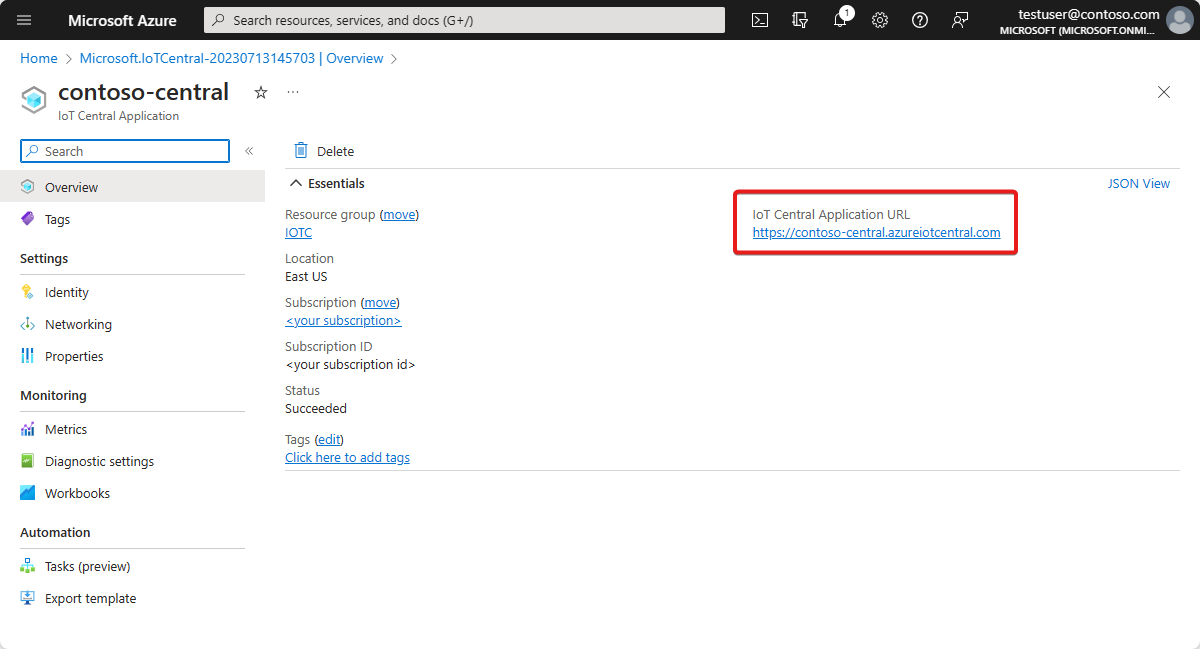
To learn more, see Create an Azure IoT Central application.
Walk through the application
The following sections walk you through the key features of the application.
Dashboard
After you deploy the application, your default dashboard is a connected logistics operator focused portal. Northwind Trader is a fictitious logistics provider managing a cargo fleet at sea and on land. In this dashboard, you see two different gateways providing telemetry from shipments, along with associated commands, jobs, and actions.
This preconfigured dashboard shows the critical logistics device operations activity.
The dashboard enables two different gateway device management operations:
- View the logistics routes for truck shipments and the details of ocean shipments.
- View the gateway status and other relevant information.
- You can track the total number of gateways, active, and unknown tags.
- You can do device management operations such as: update firmware, disable and enable sensors, update a sensor threshold, update telemetry intervals, and update device service contracts.
- View device battery consumption.
Device template
Select Device templates to see the gateway capability model. A capability model is structured around two interfaces:
- Gateway Telemetry & Property - This interface defines all the telemetry related to sensors, location, and device information. The interface also defines device twin property capabilities such as sensor thresholds and update intervals.
- Gateway Commands - This interface organizes all the gateway command capabilities.
Rules
Select the Rules tab to the rules in this application template. These rules are configured to email notifications to the operators for further investigations:
- Gateway theft alert: This rule triggers when there's unexpected light detection by the sensors during the journey. Operators must be notified immediately to investigate potential theft.
- Lost gateway alert: This rule triggers if the gateway doesn't report to the cloud for a prolonged period. The gateway could be unresponsive because of low battery, loss of connectivity, or device damage.
Jobs
Select the Jobs tab to create the jobs in this application. The following screenshot shows an example of created jobs:
You can use jobs to do application-wide operations. The jobs in this application use device commands and twin capabilities to do tasks such as disabling specific sensors across all the gateways or modifying the sensor threshold depending on the shipment mode and route:
- It's a standard operation to disable shock sensors during ocean shipment to conserve battery or lower temperature threshold during cold chain transportation.
- Jobs enable you to do system-wide operations such as updating firmware on the gateways or updating service contract to stay current on maintenance activities.
Clean up resources
If you don't plan to continue using this application, you can delete it:
- In your Azure IoT Central application, go to Application > Management.
- Select Delete, and then confirm your action.
